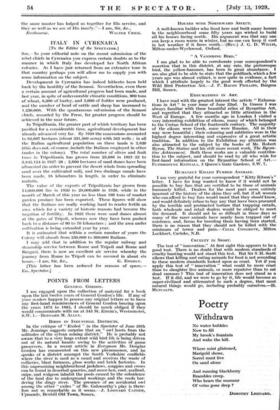ITALY IN CYRENAICA
[To the Editor of the SPECTATOR.]
Stn,—In your editorial note on the recent submission of the rebel chiefs in Cyrenaica you express certain doubts as to the manner in which Italy has developed her North African colonies. As I have just returned from an extensive tour in that country perhaps you will allow me to supply you with some information on the subject.
Development in Cyrenaica has indeed hitherto been held back by the hostility of the Senussi. Nevertheless, even there a certain amount of agricultural progress had been made, and last year, in spite of unfavourable climatic conditions, 900 tons of wheat, 6,300 of barley, and 5,000 of fodder were produced, and the number of head of cattle and sheep has increased to 1,250,000. With the spontaneous submission of the Senussi chiefs, recorded by the Press, far greater progress should be achieved in the near future.
In Tripolitania, the greater part of which territory has been 'pacified for a considerable time, agricultural development has already advanced very far. By 1928 the concessions amounted to 92,607 hectares (about 231,500 acres) with 582 wells : in all the Italian agricultural population on these lands is 2,620 (this does not, of course, includethe Italians employed in other trades in the colony). The total number of olives and fruit trees in Tripolitania has grown from 23,686 in 1921-22 to 3,843,134 in 1927-28 ; 2,600 hectares of sand dunes have been afforested (in order to prevent the desert winds from spreading sand over the cultivated soil), and two drainage canals have been made, 18 kilometres in length, in order to eliminate malaria.
The value of the exports of Tripolitania has grown from 14,000,000 lire in 1920 to 28,000,000 in 1928, while in the month of March of this year no less than 169 tons of market garden produce has been exported. These figures will show that the Italians are really working hard to render fertile an area which for a variety of historic reasons had become the negation of fertility. In 1923 there were sand dunes almost at the gates of Tripoli, whereas now they have been pushed back to a distance of 60 to 70 kilometres ; and the area under cultivation is being extended year by year.
It is estimated that within a certain number of years the Colony will absorb from 250,000 to 300,000 Italians.
I may add that in addition to the regular railway and steamship service between Rome and Tripoli and Rome and Bengazi, there is now an excellent air service whereby the journey from Rome to Tripoli can be covered in about six
hours.—I am, Sir, &c., G. ENGELY. [This letter has been reduced for reasons of space.— En. Spectator.]
































 Previous page
Previous page